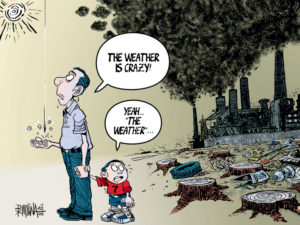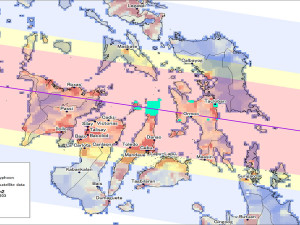
Prof. Hans-Peter Plag, PhD
Mitigation and Adaptation Research Institute
(MARI)
Old Dominion University
Norfolk, Va.
www.mari.odu.edu
In 2013, James Balog’s presentation at the scince policy conference of the American Geophysical Union (AGU) in Washington, D.C., motivated me to think about humanity as a planetary accident, causing the sixth major mass extinction event in Earth’s long history.1 Again, a presentation at an AGU meeting, this time the Fall meeting in San Francisco, set things right: James White, the Chair of the Working Group on Abrupt Climate Change Impacts of the National Research Council (NRC) attracted a huge crowd for his talk2 about exactly that: how abruptly can things change and how big can the impacts be? In 2013, the NRC Working Group published a report,3 which was rather moderate. James White, in his presentation, was not.
Even I, in all my presentations, which some find terrifying, have hesitated to present the full extent of what I think is likely going to happen. James White went to the full length, and rightly so. The time has come when science no longer can rule out many “worst case” scenarios that might be worse than the scenario described by Naomi Oreskes and Conway in their “Collapse of the Western Culture.”4 Tim Lenton used the analogy of being with a group of strangers in a small boat drifting down an unknown river and hearing a slowly growing rumbling in the far distance to picture the difficulty of communicating the threat we are facing.5 James White used the same picture of a small boat in the middle of the Niagara River approaching the Niagara Falls to illustrated the fact that the threshold is not when the boat goes down the fall, but much further up the river, when the group in the boat loses the option to get safely to the shore. Thresholds are normally not visible and dramatic as Niagara Falls; they are hidden, silent… but crossing them determines destiny.
The most worrisome threshold we may have already crossed is the one for sea level. Sea level will rise, and it will rise much more than we want to acknowledge, and far more than the current numerical models predict. The sea level rise humanity has to face will be a disaster and this disaster is being nurtured today – so much that minor impacts are being felt already, and bigger ones are around the corner. It is time then for us to focus our efforts on minimizing the impacts and reducing the scope of the disaster, instead of discussing the questions of “why, when, and how much.” It is an emergency humanity is about to face and we are past the stage of counting years and calculating inches.
Consider that over the last million years, atmospheric carbon dioxide (CO2) varied between roughly 170 ppm (parts per million) during ice ages and 300 ppm during warm periods like ours. During ice ages, global sea level was 130 m (meters) lower than today. Thus, a range of 130 ppm in CO2 correlates with roughly 130 m in global sea level.
Very simply put, we have 1 m sea level per 1 ppm in CO2. Of course, during times of global warming, sea level was lagging in time behind the CO2 and temperature increases, but eventually sea level caught up to match this simple relationship. The main contribution to these changes in sea level comes from changes in the water stored in land-based ice sheets. Of course, this correlation cannot hold to much higher CO2 values because at one point, all land-based ice will be gone. This point will be reached when global sea level is roughly
75 m higher than today.

FIGURE 1.
In Norfolk, VA, homeowners raise their houses by up to 8 feet to be protected against the nuisance flooding.
Today, atmospheric CO2 has already reached 400 ppm, and there is no reason to believe that this is the maximum – in fact, the current rate of increase in CO2 is higher than ever.6 400 ppm, that is 100 ppm higher than the previous maximum during the last 1 million years. This looks terribly like a threshold we have crossed and there is no return.
If the CO2-sea level correlation holds, this would mean an increase in sea level of 100 m. Of course, that is not possible since we only have ice left for 75 m. But that is bad enough and going down Niagara Falls could be the easier thing to do than facing this sea level rise. If the current trend in atmospheric CO2 and other GHGs continues, and the planet warms by 4 degrees Celsius or more, it may take a few hundred to thousand years to melt the land-based ice, but eventually this will happen.

FIGURE 3.
Raising the house may avoid flooding of the house, but the properties are frequently cut off (like islands) because roads are flooded and no services can get to the properties. In the face of a potentially large sea level rise, this is not adaptation but rather ignorance in the face of the knowledge we have about the likely future.
What is almost unbelievable is that most of us want to believe that we can get away with roughly one meter by 2100 and a little more in the following centuries. This is what our scientific knowledge seems to indicate, at least if you don’t read the last report of the Intergovernmental Panel on Climate Change (IPCC) very carefully. The sea level projections discussed in this report do not include accelerated contributions from the ice sheets, and the only reason for that is that we do not know how the ice sheets are going to respond to the unprecedented speed of global warming that is taking place. We think, we can get away with a global sea level rise two orders of magnitude smaller than what seems to be the rule for the last 1 million years. It reminds me of kids who set the house on fire and then believe that by some magic the fire will not burn down the house.
Yet, we are not kids. The 20th century events alone should have been enough to awaken us to the consequences of such failure in judgment, especially by leaders of the nations who knew better.
Another serious situation, where the leaders of several countries chose not to see an emerging threat, was the time before the second world war (WW2). Adolf Hitler was very clear about his intentions; he even published them in books. Nevertheless, in September 1938, leaders of France and Great Britain met with Hitler to discuss his demands, ultimately granting the German leader control over the Sudetenland region of Czechoslovakia. In return, Hitler promised to leave the rest of Czechoslovakia alone, and to abandon all further ambitions of territorial expansion. The French and British leaders made the choice to ignore the evidence and instead hoped for the unlikely.
Our leaders of today are negotiating an enemy as powerful and as determined as Hitler was, and it is clear where this is heading. But we are not ready to accept the obvious and come to the right conclusions – to reduce the risk associated with a rapid sea level rise and to increase our resilience by preparing to move out of the coastal zone when it will be necessary. This has the potential for a disaster as big as WW2.
Most coastal zones are no longer pristine environments where only some ecosystems would be submerged during the massive inundations we will without a doubt see in the future. Many coastal zones are industrialized and have been engineered, they are polluted, misused for landfills with all types of waste, and in many locations we have areas with highly toxic contaminations. In the U.S., some of the “Superfund Sites” are in locations increasingly exposed to inundation.7 Flooding these areas will lead to massive pollution, threatening the marine environment, degrading and poisoning crucial food resources, and throwing those who depend on coastal ecosystems for their food into long-lasting health problems and famine.
Instead of protecting coastal settlements and keeping them growing, we need to slowly migrate them to higher and safer grounds. Refocusing our economy on this task would create a huge amount of jobs and at the same time increase resilience and reduce disaster risk. Jim White indicated that the national flood insurance soon could cost the country more than social welfare. Instead of spending all this money on insuring flood-exposed infrastructure, it would be better to provide the funds to reduce exposure to flooding.
The action of the day is to clean up and to prepare the coasts for inundation of water. We need a major effort to map all critical infrastructure that could lead to pollution or other problems, and we need to remove these from the coastal zone. Eventually, they need to be moved high enough to be safe from inundation. A global sea level rise of 75 m means that local sea level can change much more, which is due to the gravitational effect of the ice masses and the elastic response of the solid earth to the shifting loads. Simply put, sea level rise is much smaller than the global average close to a melting ice mass and much larger further away from it. Since most of the melt water will come from Antarctica (almost 90%), local sea level rise on the northern hemisphere will be more like 100 m, while large parts of the southern hemisphere will see much less than 75 m.
We need to realize that the coastal zone is borrowed from the world’s oceans and they are about to take it back.
Meanwhile, the immediate challenge we have is the increasing “nuisance flooding,” as some call it, which are floods that are on the order of half a meter above the local high tide and in many locations are enough to cause problems but not pose severe threats to human life. Living in Hampton Roads, Virginia, I hear about that almost every day, and much of the science of the day is focused on quantifying and predicting the trajectories of this “nuisance flooding.”8
Many coastal cities experience more frequent inundation because even the very slow rate of current sea level rise puts them closer to the tidal range. As a consequence, the combination of high tides with minor meteorological surges leads to increasing inundation of the built environment. The tides gain more influence of peoples’ daily life, and the economic impacts are growing. They try to adapt by mitigating the impacts of the rising sea levels on the rapidly growing coastal settlements. However, the more we learn to cope with this slow sea level rise and continue to extend coastal infrastructure and settlements, the less we are prepared for the rapid sea level rise we are committed to.
In fact, protecting the coast through massive engineering of dikes and levies, as is standard, for example, for The Netherlands and is planned for places like New York City, attracting more population and more infrastructure into areas that one day in the not-too-distant future will be inundated and permanently under water is not the solution. The more we build in these areas, the more we leave for future generations to remove – or to accept that the ruins will be in the ocean, potentially polluting the waters. True adaptation to the large sea level rise we have committed to because of the wasteful use of energy and resources of modern society would entail a fundamental change in how we use and settle in the coastal zone.
We would have to accept the basic truth that the built environment that is less than 75 m above sea level has to be transient, built in a way that it can easily be moved to higher grounds when sea levels start to rise swiftly. The current use of the coastal zone is irresponsible, increasing disaster risk rapidly. It is putting an unacceptable load on the shoulders of our children and their children. It makes me deeply sad to see that we seem to sacrifice their future for our own short-term advantage.
Endnotes:
1 Plag, H.-P., 2013. Uncontrolled Experiment or Planetary Accident? The Global High-Energy, Growth-Addicted Civilization is an “Extinction-Class Event.” “On The Edge” column, Apogeo Spatial, 28(4), Fall 2013, 14-15.
2 White, J., 2014. Abrupt climate change: The view from the past, the present and the future. See https://agu.confex. com/agu/fm14/meetingapp. cgi#Paper/25728.
3 Abrupt Impacts of Climate Change: Anticipating Surprises. National Research Council, Washington, D.C., 2013. Committee on Understanding and Monitoring Abrupt Climate Change and Its Impacts; Board on Atmospheric Sciences and Climate; Division on Earth and Life Studies.
4 Oreskes, N. and Conway, E. M., 2014. The Collapse of the Western Civilization: A View From the Future. Columbia University Press.
5 Lenton, T. M., 2014. Game Theory: Tipping Climate Cooperation. Nature Climate Change, 4, 14-15, DOI: 10.1038/nclimate2078.
6 WMO Greenhouse Gas Bulletin, WMO Bulletin 10, 6 November 2014, available at http://www.wmo.int/pages/ prog/arep/gaw/ghg/GHGbulletin.html.
7 See the information available at http://www.epa.gov/superfund/ sites/.
8 Sweet, W. V., Park, J., 2014. From the Extreme to the Mean: Acceleration and Tipping Points of Coastal Inundation from Sea Level Rise. Earth Future, DOI: 10.1002/2014EF000272.





